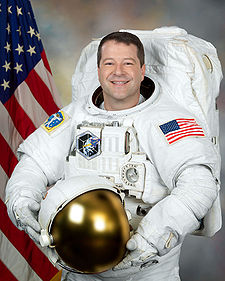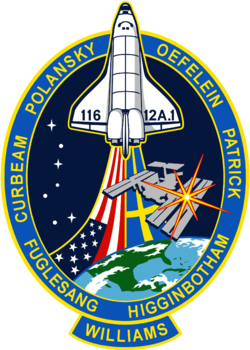Nicholas Patrick
| Nicholas Patrick | |
|---|---|
 Nicholas Patrick | |
| Astronaut NASA | |
| Státní příslušnost | |
| Datum narození | 19. listopadu 1964 (58 let) |
| Místo narození | Saltburn-by-the-Sea , Spojené království |
| Předchozí zaměstnání | vědec |
| Čas ve vesmíru | 26 dní, 14 hodin a 52 minuty |
| Kosmonaut od | 1998 |
| Mise | STS-116, STS-130 |
| Znaky misí | |
| Některá data mohou pocházet z datové položky. | |
Nicholas James McDonald Patrick (* 19. listopadu 1964 v Saltburn-by-the-Sea, hrabství Severní Yorkshire, stát Spojené království, je anglo-americký doktor filozofie a kosmonaut. Ve vesmíru byl dvakrát.
Život
Studium a zaměstnání
Absolvoval střední školu Harrow School v městě Londýn, stát Spojené království (zakončil roku 1982) a poté ve studiu pokračoval na University of Cambridge. Zde studoval až do roku 1990. V dalším studiu pokračoval v americkém Massachusetts Institute of Technology, kde získal v roce 1996 doktorát.
Zaměstnání získal u společnosti Boeing Commercial Airplane Group v Seattlu. V letech 1998 až 2000 absolvoval výcvik budoucích kosmonautů v Houstonu, poté byl zařazen do tamní jednotky astronautů NASA.
Zůstal svobodný. Má přezdívku Nick.
Lety do vesmíru
Na oběžnou dráhu se v raketoplánu dostal dvakrát ve funkci letového specialisty, pracoval na orbitální stanici ISS, strávil ve vesmíru celkem 26 dní, 14 hodin a 52 minut. Absolvoval také 3 výstupy do volného vesmíru (EVA) v celkové délce pobytu 18 hodin a 14 minut. Byl 450 člověkem ve vesmíru.
- STS-116 Discovery (10. prosinec 2006 – 22. prosinec 2006)
- STS-130 Endeavour (8. únor 2010 – 21. únor 2010)
Odkazy
Externí odkazy
 Obrázky, zvuky či videa k tématu Nicholas Patrick na Wikimedia Commons
Obrázky, zvuky či videa k tématu Nicholas Patrick na Wikimedia Commons - Na webu Space
- Na webu MEK-Kosmo
Média použitá na této stránce
The STS-116 patch design signifies the continuing assembly of the International Space Station (ISS). The primary mission objective is to deliver and install the P5 truss element. The P5 installation will be conducted during the first of three planned spacewalks, and will involve use of both the shuttle and station robotic arms. The remainder of the mission will include a major reconfiguration and activation of the ISS electrical and thermal control systems, as well as delivery of Zvezda Service Module debris panels, which will increase ISS protection from potential impacts of micro-meteorites and orbital debris. In addition, a single expedition crewmember will launch on STS-116 to remain onboard the station, replacing an expedition crewmember that will fly home with the shuttle crew. The crew patch depicts the space shuttle rising above the Earth and ISS. The United States and Swedish flags trail the orbiter, depicting the international composition of the STS-116 crew. The seven stars of the constellation Ursa Major are used to provide direction to the North Star, which is superimposed over the installation location of the P5 truss on ISS. The NASA insignia design for shuttle space flights is reserved for use by the astronauts and other official use as the NASA Administrator may authorize. Public availability has been approved only in the form of illustrations by the various news media. When and if there is any change in this policy, which is not anticipated, such will be publicly announced.
The official patch for STS-130. The shape of the patch represents the Cupola, which is the windowed robotics viewing station, from which astronauts will have the opportunity not only to monitor a variety of ISS operations, but also to study our home planet. The image of Earth depicted in the patch is the first photograph of the Earth taken from the moon by Lunar Orbiter I on August 23, 1966. As both a past and a future destination for explorers from the planet Earth, the moon is thus represented symbolically in the STS-130 patch. The Space Shuttle Endeavour is pictured approaching the ISS, symbolizing the Space Shuttle's role as the prime construction vehicle for the ISS.
Astronaut Nicholas J. M. Patrick, mission specialist



